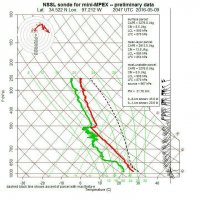Trey Thee
EF2
A potent severe weather setup appears in place for tomorrow. Right now I tend to think the enhanced risk may be moved slightly back to the west, perhaps right along the I35 corridor instead of just to the east.
OK - Wind profiles seem adequate to support supercell storms with all modes of severe weather. There is some backing winds showing up on a couple of the models but it is relatively minor. Low level moisture will also be adequate. Mid 60s dew points and moisture depth being better than today we could see a substantial tornado threat develop just off the dry line back to the OK/ARK border.
The 4k NAM is decidedly more aggressive with moisture return over the NAM and GFS so I'd disregard the moisture on the latest 4k. But wind profiles which it seems to generally do better at forecasting become decidedly more backed at the surface after 7pm. Composite reflectivity on both the NAM and 4k indicate storms breaking out off the dry line and pushing into the Tulsa area between 7 and 8pm. Simultaneously the above mentioned surface winds become more conducive to tornadic development.
In Arkansas it appears initiation could begin by 5 pm. Again some backing occurs at roughly 600mb to 500mb but it's minor as indicated at this point. Storm relative helicity looks ample over Arkansas as well. The overall environment in Arkansas may prove to be the most dynamic, especially from 7pm to midnight. Nocturnal tornadoes seem possible with this setup.
The sight risk extends well north of Kansas City, it includes Omaha and SW Iowa. North east Texas falls under the enhanced risk and an isolated cell that could get going in NE Texas will have better moisture to work with.
I would target the dry line in Oklahoma, I40 up to the KS border or west central Arkansas tomorrow.
OK - Wind profiles seem adequate to support supercell storms with all modes of severe weather. There is some backing winds showing up on a couple of the models but it is relatively minor. Low level moisture will also be adequate. Mid 60s dew points and moisture depth being better than today we could see a substantial tornado threat develop just off the dry line back to the OK/ARK border.
The 4k NAM is decidedly more aggressive with moisture return over the NAM and GFS so I'd disregard the moisture on the latest 4k. But wind profiles which it seems to generally do better at forecasting become decidedly more backed at the surface after 7pm. Composite reflectivity on both the NAM and 4k indicate storms breaking out off the dry line and pushing into the Tulsa area between 7 and 8pm. Simultaneously the above mentioned surface winds become more conducive to tornadic development.
In Arkansas it appears initiation could begin by 5 pm. Again some backing occurs at roughly 600mb to 500mb but it's minor as indicated at this point. Storm relative helicity looks ample over Arkansas as well. The overall environment in Arkansas may prove to be the most dynamic, especially from 7pm to midnight. Nocturnal tornadoes seem possible with this setup.
The sight risk extends well north of Kansas City, it includes Omaha and SW Iowa. North east Texas falls under the enhanced risk and an isolated cell that could get going in NE Texas will have better moisture to work with.
I would target the dry line in Oklahoma, I40 up to the KS border or west central Arkansas tomorrow.

